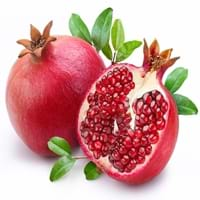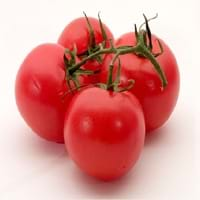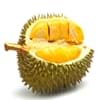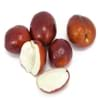Health Benefits
Cancer prevention, Heart care, Helps in cartilage regeneration, Improves stomach health, Increase in haemoglobin, Increases metabolic rate, Prevents constipation
Anti depressant, Cancer prevention, Heart care, Muscle pain relief, Prevents constipation, Regulation of heart rate, Weight loss properties
General Benefits
Boosts immune system, Controls blood pressure, Controls blood sugar levels, Digestive aid, Maintains healthy cholesterol level
Controls blood pressure, Eye care, Maintains healthy cholesterol level, Strengthens bones
Skin Benefits
Anti-aging benefits, Skin rejuvenation, Treatment of acne
Anti-aging benefits, Heals sunburn, Skin rejuvenation, Treatment of acne, Treatment of skin diseases
Hair Benefits
Prevents hair loss, Promotes longer and healthier hair, Treatment of dandruff
Good conditioner, Prevents hair loss, Softening mask
Allergy Symptoms
Abdominal pains, Anaphylaxis, Itching
Anaphylaxis, Coughing, Diarrhea, Eczema, Hives, Itching sensation in throat, Nausea, Skin Rashes, Runny nose, Sneezing, Swelling of mouth, tongue or lips, Vomiting, Wheezing
Side Effects
Allergic reaction, Cold, Breathing difficulty, Irritation, Swelling
Heart burn
Best Time to Eat
Best if taken as a breakfast (or empty stomach), As a snack in the late afternoon, Eat the fresh ones, avoid mixing with any other foods, don't eat after meal., Morning time (before lunch)
Along with meal, Don't consume at night and before bed, Morning time (before lunch)
Vitamin B5 (Pantothenic Acid)
Vitamin C (Ascorbic Acid)
Vitamin K (Phyllochinone)
Phytosterol
Not Available
Calories in Fresh Fruit with Peel
Not Available
Calories in Fresh Fruit without Peel
Not Available
Calories in Frozen Form
Not Available
Calories in Canned Form
Not Available
Type
Tree fruit
Berry, Fruit vegetable
Season
Autumn
All seasons
Varieties
Balegal, Crab, Cloud, Francis, Freshman and Granada
Better Boy, Early Girl, Beefsteak, Beefmaster, Pink Brandywinem, Caspian Pink, Thai Pinks, Hawaiian Pineapple, Kellogg’s Breakfast, Cherokee Purple, Black Ethiopian and Paul Robeson
Color
Dark red, Light pink-red
Green, Orange, Pink, Purplish black, Red, White, Yellow
Taste
Juicy, Sweet
Sour, Sweet
Origin
India, Iran
Central America, South America
Soil Type
Clay, Sand
Loam, Sandy loam
Climatic Conditions
Cold, Dry, Hot
Sunny, Warm
Facts about
- Pomegranate means apple with many seeds.
- It was called as the “apple of Grenada” in early English.
- In Hinduism, this fruit symbolizes prosperity and fertility.
- Pomegranate trees can live upto 200 years.
- Around 10,000 varieties of tomatoes are grown in the world.
- In Buñol, people celebrate the Tomatina festival where around 1.5 lakh tomatoes are used.
- As per Guinness book of records, heaviest tomato weighed 3.51 kg.
Other Countries
Africa, India, Middle east, Pakistan
Brazil, Egypt, India, Iran, Italy, Mexico, Spain, Turkey, United States of America
Top Importer
Europe
Nigeria
Top Exporter
India
Netherlands
Botanical Name
Punica granatum
Solanum lycopersicum
Synonym
Punica malus
Lycopersicon esculentum
Subkingdom
Tracheobionta
Tracheobionta
Division
Magnoliophyta
Magnoliophyta
Class
Magnoliopsida
Magnoliopsida
Subclass
Rosidae
Asteridae
Family
Lythraceae
Solanaceae
Species
P. granatum
S. lycopersicum
Generic Group
Pomegranate
Nightshade
Compare Pomegranate and Tomato
It is important compare Pomegranate and Tomato as both the fruits have a different nutritional value. Their comparison can be done on the basis of their vitamin and mineral content, calories, benefits as well as characteristics, making it easier for us to choose the best fruit for our diet. Their general health benefits are as follows:
Pomegranate Benefits: boosts immune system, controls blood pressure, controls blood sugar levels, digestive aid and maintains healthy cholesterol level.
Tomato Benefits: controls blood pressure, eye care, maintains healthy cholesterol level and strengthens bones.
Fruits are also used as a remedy for various hair problems. The hair benefits of Pomegranate are: prevents hair loss, promotes longer and healthier hair and treatment of dandruff and hair benefits of Tomato are: good conditioner, prevents hair loss and softening mask. Some fruits are known to cause allergic reactions. The allergy symptoms of first fruit are: abdominal pains, anaphylaxis and itching and the symptoms of second fruit are: anaphylaxis, coughing, diarrhea, eczema, hives, itching sensation in throat, nausea, skin rashes, runny nose, sneezing, swelling of mouth, tongue or lips, vomiting and wheezing. Get sorted Pomegranate vs Tomato comparison with the help of fruit comparison tool by fruitvs.com.









